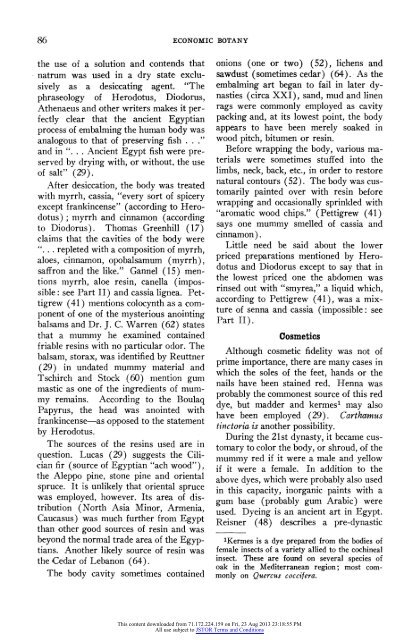The Botanical Aspects of Ancient Egyptian Embalming and Burial
The Botanical Aspects of Ancient Egyptian Embalming and Burial
The Botanical Aspects of Ancient Egyptian Embalming and Burial
Create successful ePaper yourself
Turn your PDF publications into a flip-book with our unique Google optimized e-Paper software.
86 ECONOMIC BOTANY<br />
the use <strong>of</strong> a solution <strong>and</strong> contends that<br />
natrum was used in a dry state- exclusively<br />
as a desiccating agent. "<strong>The</strong><br />
phraseology <strong>of</strong> Herodotus, Diodorus,<br />
Athenaeus <strong>and</strong> other writers makes it perfectly<br />
clear that the ancient <strong>Egyptian</strong><br />
process <strong>of</strong> embalming the human body was<br />
analogous to that <strong>of</strong> preserving fish . .<br />
<strong>and</strong> in ". . . <strong>Ancient</strong> Egypt fish were preserved<br />
by drying with, or without, the use<br />
<strong>of</strong> salt" (29).<br />
After desiccation, the body was treated<br />
with myrrh, cassia, "every sort <strong>of</strong> spicery<br />
except frankincense" (according to Herodotus);<br />
myrrh <strong>and</strong> cinnamon (according<br />
to Diodorus). Thomas Greenhill (17)<br />
claims that the cavities <strong>of</strong> the body were<br />
"... repleted with a composition <strong>of</strong> myrrh,<br />
aloes, cinnamon, opobalsamum (myrrh),<br />
saffron <strong>and</strong> the like." Gannel (15) mentions<br />
myrrh, aloe resin, canella (impossible:<br />
see Part II) <strong>and</strong> cassia lignea. Pettigrew<br />
(41) mentions colocynth as a component<br />
<strong>of</strong> one <strong>of</strong> the mysterious anointing<br />
balsams <strong>and</strong> Dr. J. C. Warren (62) states<br />
that a mummy he examined contained<br />
friable resins with no particular odor. <strong>The</strong><br />
balsam, storax, was identified by Reuttner<br />
(29) in undated mummy material <strong>and</strong><br />
Tschirch <strong>and</strong> Stock (60) mention gum<br />
mastic as one <strong>of</strong> the ingredients <strong>of</strong> mummy<br />
remains. According to the Boulaq<br />
Papyrus, the head was anointed with<br />
frankincense-as opposed to the statement<br />
by Herodotus.<br />
<strong>The</strong> sources <strong>of</strong> the resins used are in<br />
question. Lucas (29) suggests the Cilician<br />
fir (source <strong>of</strong> <strong>Egyptian</strong> "ach wood"),<br />
the Aleppo pine, stone pine <strong>and</strong> oriental<br />
spruce. It is unlikely that oriental spruce<br />
was employed, however. Its area <strong>of</strong> distribution<br />
(North Asia Minor, Armenia,<br />
Caucasus) was much further from Egypt<br />
than other good sources <strong>of</strong> resin <strong>and</strong> was<br />
beyond the normal trade area <strong>of</strong> the <strong>Egyptian</strong>s.<br />
Another likely source <strong>of</strong> resin was<br />
the Cedar <strong>of</strong> Lebanon (64).<br />
<strong>The</strong> body cavity sometimes contained<br />
onions (one or two) (52), lichens <strong>and</strong><br />
sawdust (sometimes cedar) (64).- As the<br />
embalming art began to fail in later dynasties<br />
(circa XXI), s<strong>and</strong>, mud <strong>and</strong> linen<br />
rags were commonly employed as cavity<br />
packing <strong>and</strong>, at its lowest point, the body<br />
appears to have been merely soaked in<br />
wood pitch, bitumen or resin.<br />
Before wrapping the body, various materials<br />
were sometimes stuffed into the<br />
limbs, neck, back, etc., in order to restore<br />
natural contours (52). <strong>The</strong> body was customarily<br />
painted over with resin before<br />
wrapping <strong>and</strong> occasionally sprinkled with<br />
"aromatic wood chips." (Pettigrew (41)<br />
says one mummy smelled <strong>of</strong> cassia <strong>and</strong><br />
cinnamon).<br />
Little need be said about the lower<br />
priced preparations mentioned by Herodotus<br />
<strong>and</strong> Diodorus except to say that in<br />
the lowest priced one the abdomen was<br />
rinsed out with "smyrea," a liquid which,<br />
according to Pettigrew (41), was a mixture<br />
<strong>of</strong> senna <strong>and</strong> cassia (impossible: see<br />
Part II).<br />
Cosmetics<br />
Although cosmetic fidelity was not <strong>of</strong><br />
prime importance, there are many cases in<br />
which the soles <strong>of</strong> the feet, h<strong>and</strong>s or the<br />
nails have been stained red. Henna was<br />
probably the commonest source <strong>of</strong> this red<br />
dye, but madder <strong>and</strong> kermes' may also<br />
have been employed (29). Carthaius<br />
tinctoria is another possibility.<br />
During the 21st dynasty, it became customary<br />
to color the body, or shroud, <strong>of</strong> the<br />
mummy red if it were a male <strong>and</strong> yellow<br />
if it were a female. In addition to the<br />
above dyes, which were probably also used<br />
in this capacity, inorganic paints with a<br />
gum base (probably gum Arabic) were<br />
used. Dyeing is an ancient art in Egypt.<br />
Reisner (48) describes a pre-dynastic<br />
1Kermes is a dye prepared from the bodies <strong>of</strong><br />
female insects <strong>of</strong> a variety allied to the cochineal<br />
insect. <strong>The</strong>se are found on several species <strong>of</strong><br />
oak in the Mediterranean region; most commonly<br />
on Quercus coccifera.<br />
This content downloaded from 71.172.224.159 on Fri, 23 Aug 2013 23:18:55 PM<br />
All use subject to JSTOR Terms <strong>and</strong> Conditions
















